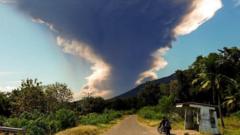Indonesia's Mount Lewotobi Laki-laki is back on the eruption radar, spewing an ash cloud as high as 18 kilometers (11 miles) into the air and terrifying nearby residents once again. Since the volcanic activity reignited on Monday, residents have been fleeing their homes to escape the dangers associated with the eruptions.
Fortunately, no casualties have been reported, but the elevated alert level from the previous eruptions shows heightened concern. The recent volcanic activity forced the cancellation of 24 flights to and from Bali, although operations resumed the following day.
Geology agency chief Muhammad Wafid noted that the initial ash cloud at 11:05 AM on Monday was the largest seen since November, indicating increased risks tied to aviation safety. As a precaution, authorities have extended the evacuation zone to a 7-kilometer radius from the crater, alerting nearby communities to potential lahar floods—mudflows that could occur with heavy rains.
The twin-peaked volcano erupted again on Monday night, and again early Tuesday, showing a decrease in intensity with each blast. Videos from the region depict mesmerizing images of glowing red lava shooting from the mountain, while thousands of locals are loaded into vehicles for evacuation. More than 4,000 individuals have been relocated so far, as reported by the local disaster management agency.
For those who remained behind, there’s growing anxiety over insufficient clean water, food shortages, and mask availability. "As the situation evolves and ash clouds drift, focused emergency aid is crucial," noted Paulus Sony Sang Tukan, a village leader situated 8 kilometers away from the volcano.
Indonesia is situated on the Pacific "Ring of Fire," which leads to frequent volcanic activity and earthquakes. This year, Mount Lewotobi Laki-laki has already shown signs of unrest, though this recent eruption hasn’t yet led to any loss of life. However, a similar eruption last November tragically resulted in ten fatalities and widespread evacuations.
The volcano's name, Laki-Laki, translates to "man" in Indonesian, and it stands alongside the more reserved but taller Perempuan, or "woman," at 1,703 meters.
Additional reporting was done by Eliazar Ballo in Kupang.



















